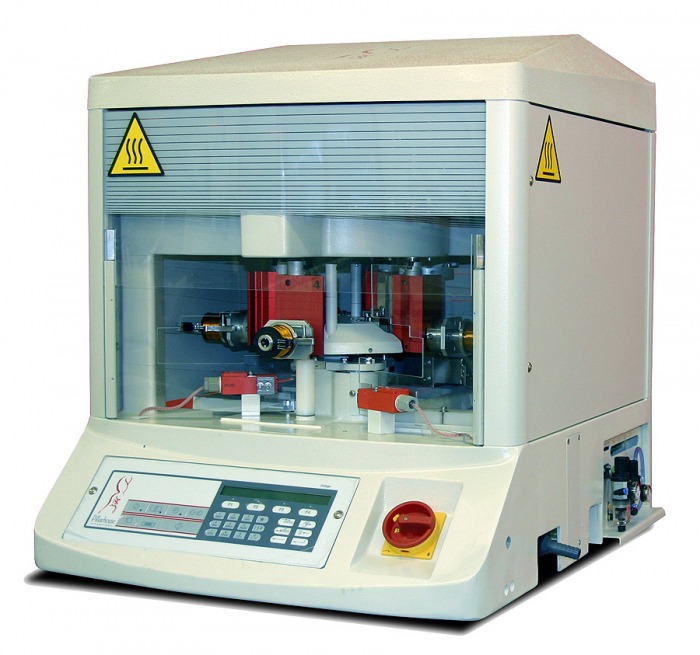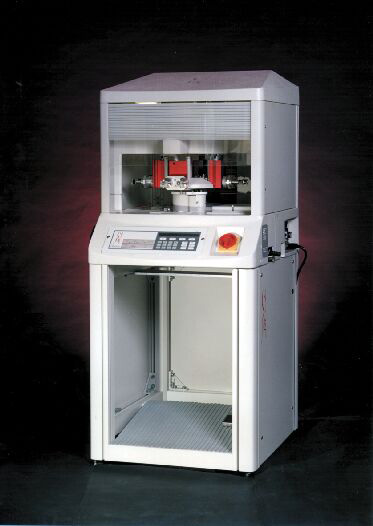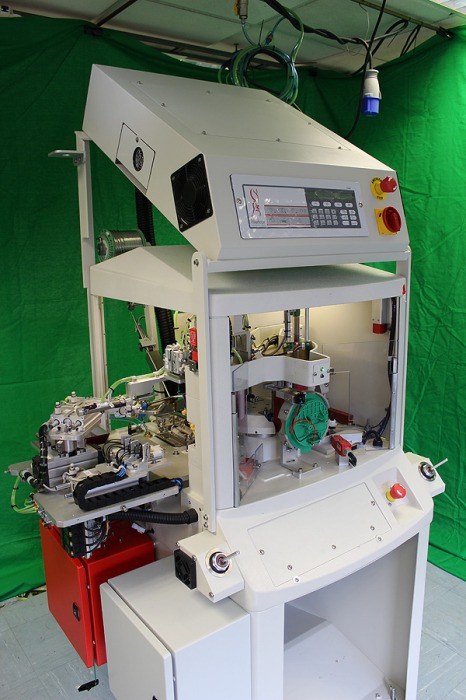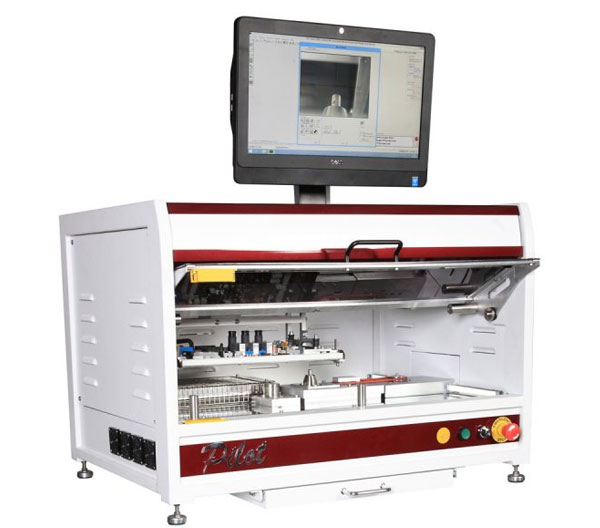
A versatile four station rotary bench top soldering machine ideally suited for high or low volume production, the Quadron, combines well proven pumped soldering techniques with advanced microprocessor technology. Much of its versatility is owed to the specially designed programming system which allows the user access to all fluxing and soldering parameters at any time, in addition, rapid product change-over is achieved quickly and easily through simple tooling design and program identification. The machine is at home both processing coils/sub-assemblies/transformers or small PCB’s in either small or large batches. Cycle times as low as 5 secs can be achieved.
Fluxing System
The flux is applied to the terminals via a crucible or sprung test probes, which is lifted from the bath to the component, this provides high quality and consistent repeatability. Flux application is of paramount importance, this is where the Quadron has an advantage, as it is able to control the application and avoid bobbin contamination by applying flux accurately. Excess flux and insulation residue is kept to a minimum by careful control of the dip height and immersion time, this being achieved through a microprocessor and stepper drive motors. The Quadron can be supplied with either a fixed flux bath or self-contained recycling flux tank which helps reduce the evaporation of the flux thinners.
Soldering
The Quadron uses a well proven solder pump system and incorporates a solder nozzle which can be of various designs to suit the product. Dross is removed from the nozzle prior to the next soldering operation
by increasing the pump speed and bursting solder from the nozzle, this occurs during the index operation and does not impede the overall cycle time. The component is dipped in the solder by means of the precision stepper driven tooling slide, which provides precise, accurate and repeatable results. Also, for the optimum soldered joint, Pillarhouse is able to provide a Nitrogen shroud which makes the soldering operation totally inert and helps prevent bridging, reduces dross and provides an improved quality. One major advantage the Quadron has is the ability to tilt a component out of the solder, this facility will help to prevent solder bridging of fine pitched connectors and the like.
Programming
The Quadron can be quickly and easily programmed to solder a wide range of different products, e.g. coils, transformers, wire terminations and small PCB’s. The machine has a memory capacity for 40 programmes (This can be increased to 160). The fluxing and soldering parameters are entered via a keyboard, to give full control of: solder bath temperature (to within ±1°C), flux and solder dip heights (increments of 0.1mm), and flux and solder immersion time (to within 0.1 of a second). Additional operations can also be controlled, e.g. component test facility, component unload and adjustment of the cycle time etc. A twenty-four hour wake-up timer is included as standard equipment which enables the machine to be automatically powered-on and bought up to temperature prior to the start of a working shift
Turnover
The optional turnover facility enables components with terminals on up to four sides to be handled on the same tooling, with fluxing and soldering performed at the same time without the need for the component to be re-loaded. Also, if a component has different soldering requirements on each side the Quadron can be programmed with different programming parameters for each side of the part.
Automatic Test/Unload
Optional continuity test and/or unload facilities offer the ability for components to be tested for electrical continuity or resistance prior to the component being automatically or manually ejected as a pass or fail.
Solder Top-up
This option ensures the solder level in the bath is kept constant; the level is automatically continually monitored using proximity switch system which instructs the system to automatically top-up the solder. This system uses a reel of 3mm diameter solder which is mounted on the rear of the machine; the solder is fed into the bath pneumatically.





Uniwersalna obrotowa stacja lutownicza idealnie nadaje się do produkcji dużej lub małej objętości, Cadet, łączy w sobie dobrze sprawdzone techniki lutowania z zaawansowaną technologią mikroprocesorową. Znaczna część jego wszechstronności wynika ze specjalnie zaprojektowanego systemu programowania, który umożliwia użytkownikowi dostęp do wszystkich parametrów topnika i lutowania, a ponadto szybką zmianę produktu uzyskuje się szybko i łatwo dzięki prostemu projektowaniu narzędzi i identyfikacji programu.
Nanoszenie topnika
Przy użyciu tego samego systemu co w procesie lutowania strumień jest doprowadzany do końcówek za pomocą tygla, co zapewnia wysoką jakość i powtarzalność. Zastosowanie topnika ma ogromne znaczenie, to tutaj Cadet ma przewagę, ponieważ jest w stanie kontrolować aplikację i unikać zanieczyszczenia szpuli przez dokładne podawanie topnika. Nadmiar strumienia i resztki izolacji są ograniczone do minimum dzięki starannej kontroli wysokości zanurzenia i czasu zanurzenia, co osiąga się dzięki mikroprocesorowi i silnikom krokowym.
Lutowanie
Cadet wykorzystuje prosty, niezawodny system statyczny, który zapewnia czyste lutowie na stałym poziomie i objętości, oferując w ten sposób powtarzalne połączenia lutowane o wysokiej jakości w każdej operacji. Tygiel lub aplikator (który może być specyficzny dla produktu, jeśli jest wymagany) jest podnoszony ze stopionej kąpieli z lutu w celu zanurzenia końcówek komponentów w aplikatorze na dokładną głębokość i przez kontrolowany okres czasu. Wszelkie zanieczyszczenia lub kożuchy są usuwane bezpośrednio z powierzchni lutu przez unikalny podwójny system czyszczenia bezpośrednio przed lutowaniem. Temperatura lutowia jest kontrolowana przez procesor i oferuje użytkownikowi możliwość podgrzewania lutu do 500 ° C, co daje możliwość użycia zarówno lutów o wysokiej jak i niskiej temperaturze.
Programowanie
Cadet może być szybko i łatwo zaprogramowany do lutowania szerokiej gamy różnych produktów, np. Cewek, transformatorów, końcówek przewodów i małych płytek PCB. Urządzenie ma pamięć do 49 programów, a parametry topnika i lutowania są wprowadzane za pomocą klawiatury, aby zapewnić pełną kontrolę: temperatury kąpieli lutowniczej (z dokładnością do ± 5 ° C), wysokości strumienia topnika i lutowania (co 0,1 mm ), oraz czas zanurzenia strumienia i lutowania (do 0,1 sekundy). Dodatkowe operacje można również kontrolować, np. narzędzie do testowania komponentów, rozładowanie komponentów i regulacja czasu cyklu itp. 24-godzinny zegar budzika jest dostarczany jako standardowe wyposażenie, które umożliwia automatyczne włączanie i wyłączanie urządzenia, co umożliwia np. nagrzanie lutowia do określonej temperatury przed rozpoczęciem zmiany..
Opcje Systemu
The Cadet, bardzo wszechstronna maszyna może być jeszcze bardziej rozbudowana poprzez dodanie różnych opcjonalnych urządzeń, niektóre opcje są wymienione poniżej.
Obrotnica
Opcjonalny moduł obrotu umożliwia obsługiwanie komponentów z końcówkami po przeciwnych stronach przy użyciu tego samego oprzyrządowania, przy jednoczesnym topieniu i lutowaniu bez konieczności ponownego ładowania podzespołu. Ponadto, jeśli komponent ma różne wymagania dotyczące lutowania po każdej stronie, kadet zidentyfikuje różne parametry programowania.
Automatic Test/Unload
Opcjonalne urządzenia testujące i / lub wyładowujące umożliwiają przetestowanie komponentów pod kątem ciągłości elektrycznej lub odporności przed wyrzuceniem / rozładowaniem komponentu automatycznie lub ręcznie w funkcji przejścia lub usterki.
Kontroler gęstości topnika FDC
Ta opcja jest oddzielną samodzielną maszyną i znajduje się na podłodze sąsiadującej z częścią lutującą, kontroluje lepkość topnika i utrzymuje go przy właściwej grawitacji. FDC jest podłączony do maszyny do lutowania i nieustannie ponownie cyrkuluje topnik pomiędzy nim a zbiornikiem topnika w maszynie. Po powrocie do FDC topnika, przechodzi przez Hydrometr, który monitoruje jego lepkość, jeśli staje się zbyt gęsty, dodaje się rozcieńczalniki, aż do uzyskania odpowiedniej konsystencji.
Specyfikacja

Designed to meet the needs of the small batch manufacturer who requires high levels of production flexibility. The Jade Prodex offers the ability to regularly change solder alloys without incurring expensive down time, whilst the solder bath cools down and heats up during a regular manual changeover process.
The Prodex is an offline system, incorporating a quick load twin PCB universally adjustable rotary table transport system to allow simultaneous load / unload during product processing.
In its basic format, the Prodex is configured with a single solder bath. In its Duplex guise, the machine can be configured with twin adjacent solder baths on independent Z axis drives. This achieves increased production flexibility by permitting use of two different nozzle tip sizes which can be allocated as process requirements dictate within any particular area on a PCB.
All Prodex configurations can be offered with optional automatic heated solder bath change stations. Using this system the non-operational solder bath and pump system can be stationed at one of the two optional heated park positions located at either side of the main machine. This heated station, maintains the correct solder temperature within the bath that is idle so that when changeover occurs, the replacement bath can resume immediate production. A single automatic solder bath change station is identified as a PLUS configuration, whilst twin stations (located at both sides of the machine) are identified as PLUS PLUS configurations. On this basis Duplex machines with the PLUS PLUS identity will operate with 4 individual solder bath and pump systems.
The Prodex series is controlled by a PC, through PillarCOMM, a Windows® based ‘Point & Click’ interface with a PCB image display.
Additionally our optional PillarPAD offline programming package allows the operator to produce programs independently from the machine using Gerber data.

Designed to meet the needs of the small batch manufacturer who requires high levels of production flexibility. The Jade PRO offers the ability to regularly change solder alloys without incurring expensive down time, whilst the solder bath cools down and heats up during a regular manual changeover process.
The Jade PRO is a hand load system, incorporating a universally adjustable tooling carrier capable of accommodating PCBs or pallets up to 457x508mm.
In its basic format, the Jade PRO is configured with a single solder bath. In the Jade PRO Duplex guise, the machine can be configured with twin adjacent solder baths on independent Z axis drives. This achieves increased production flexibility by permitting use of two different nozzle tip sizes which can be allocated as process requirements dictate within any particular area on a PCB.
All of the above Jade PRO configurations can be offered with optional automatic heated solder bath change stations. Using this system the non-operational solder bath and pump system is stationed at one of two heated park positions located at either side of the main machine.
This heated station maintains the correct solder temperature within the bath that is idle, so that when changeover occurs, the replacement bath can resume immediate production. A single automatic solder bath change station is identified as a PLUS configuration, whilst twin stations (located at both sides of the machine) are identified as PLUS PLUS configurations.
On this basis Duplex machines with the PLUS PLUS identity will operate with 4 individual solder bath and pump systems.
The Jade PRO series is controlled by a PC, through PillarCOMM, a Windows® based ‘Point & Click’ interface with a PCB image display.
Additionally our PillarPAD offline programming package allows the operator to produce programs independently from the machine using Gerber data.

Zaprojektowany, aby zaspokoić potrzeby małych producentów elektroniki. Jade-Handex oferuje dużą szybkość i elastyczność przy minimalnych kosztach. Jade-Handex jest wyposażony w rewolucyjny podwójny układ transportowy z obrotowym stołem PCB, który umożliwia jednoczesne ładowanie / rozładowywanie podczas przetwarzania produktu.
Nasz opatentowany fluxer nowej generacji typu drop-jet oferuje szybkie i skuteczne nanoszenie topnika z zbiornika ciśnienieniowego. Pomaga to w utrzymaniu poziomu konserwacji na minimalnym poziomie, umożliwiając jednocześnie stosowanie topników o wyższej zawartości ciał stałych, jak również topników rozpuszczalnych w wodzie.
W ramach podstawowej filozofii tego systemu opracowano nową wannę lutowniczą o niskim poziomie konserwacji i mechanizm pompy, który porusza się w trzech osiach ruchu, nie ograniczając jednocześnie dostępu do PCB. Lutowie jest dostarczanie przy użyciu sprawdzonej technologii dzięki naszemu projektowi dysz AP-1 lub niestandardowym specjalnym dyszom, w których zastosowano opatentowany spiralny powrót lutowia do technologii kąpieli o zmniejszonym potencjale lutowania.
Podobnie jak w przypadku bardziej zaawansowanych systemów Pillarhouse, proces lutowania jest rozszerzony przez obojętną gorącą kurtynę azotową, która zapewnia obojętną atmosferę dla procesu lutowania, a także pomaga w zapobieganiu utlenianiu lutowia. Proces ten zapewnia lokalne podgrzanie punktu lutowania , zmniejszając w ten sposób szok termiczny dla komponentów.
Jade-Handex jest kontrolowany przez komputer PC, poprzez interfejs PillarCOMM, oparty na systemie Windows® „Point & Click” z wyświetlaniem obrazu PCB. Dodatkowo nasz pakiet offline PillarPAD pozwala operatorowi tworzyć rogramy niezależnie od maszyny przy użyciu danych Gerber

Zaprojektowany, aby zaspokoić potrzeby małego i średniego seryjnego producenta, który wymaga dużej elastyczności produkcji, podstawowy system Jade MKll oferuje bezkompromisową jakość lutowania selektywnego przy bardzo niskich kosztach.
Jade MKII to system ręcznego ładowania, zawierający uniwersalnie regulowany nośnik narzędzi, który może pomieścić PCB lub palety o wymiarach do 457 x 508 mm.Nasz opatentowany fluxer Drop-Jet oferuje szybkie i skuteczne nanoszenie topnika ze zbiornika ciśnieniowego. Pomaga to w utrzymaniu poziomu konserwacji na minimalnym poziomie, umożliwiając jednocześnie stosowanie topników o większej zawartości substancji stałych oraz topnika rozpuszczalnego w wodzie
W ramach podstawowej filozofii tego systemu opracowano wannę lutowniczą o niskim poziomie konserwacji i mechanizm pompy, który porusza się w trzech osiach ruchu, nie ograniczając jednocześnie dostępu do PCB. Lutowanie jest stosowane przy użyciu sprawdzonej technologii dzięki naszemu projektowi dysz AP lub specjalnym specjalnym dyszom, w których zastosowano opatentowany spiralny powrót lutowia do technologii kąpieli o zmniejszonym potencjale lutowania.
Podobnie jak w przypadku wszystkich systemów Pillarhouse, proces lutowania jest wzmocniony przez gorącą kurtynę azotową, która zapewnia obojętną atmosferę. Ta metoda lutowania pomaga również w zapobieganiu utlenianiu i zapewnia lokalne podgrzanie punktu lutowniczego, zmniejszając w ten sposób szok termiczny do lokalnych elementów.
Jade MKII jest kontrolowany przez komputer PC, poprzez interfejs PillarCOMM, oparty na systemie Windows® „Point & Click” z wyświetlaniem PCB. Dodatkowo nasz pakiet offline PillarPAD pozwala operatorowi tworzyć programy niezależnie od maszyny przy użyciu danych Gerber
.
Zintegrowany z maszyną PC z monitorem TFT
System azotu obojętnego
Automatyczne doładowanie lutowia (podawanie drutu) i wykrywanie poziomu lutowania
Drop-Jet fluxer
Zestaw końcówek dysz lutowniczych typu AP
Wewnętrzna ekstrakcja oparów
Kamera kolorowa do programowania
Pomiar i korekta wysokości fali lutowniczej
Uniwersalnie regulowany nośnik narzędzi
System kalibracji dysz termicznych za pomocą zintegrowanej kamery (wymaga ręcznej korekty)
Interfejs „Point & Click” oparty na systemie PillarCOMM Windows®
Wielopoziomowe zabezpieczenia hasłem
Ręczna korekcja położenia znaczników
Kompatybilność z procesem bez ołowiowym
Codzienny zestaw serwisowy
Czujnik obecności topnika – termistor
Monitorowanie rozpylania i przepływu topnika
Monitorowanie ilości tlenu O2 ppm
Monitorowanie obrotów pompy
Monitorowanie przepływu azotu
Natychmiastowe podgrzewanie IR od góry
Regulacja temperatury w zamkniętej pętli – za pomocą pirometru lub termopary
Podgrzewacz pierścieniowy IR od dołu
Podgrzewane selektywnie azotowe podgrzewanie od dołu
Automatyczna korekta fiducial
Topnik ultradźwiękowy
Podwójne upuszczanie kropelkowe / ultradźwiękowe
Laserowa korekcja osnowy PCB
Zespół dyszy Micro
Identyfikacja szpuli lutowniczej
Szybka wymiana wanny lutowniczej i możliwości układu pompy – nie obejmuje wanny lutowniczej i pompy
Kodowanie wanny lutowniczej – identyfikuje prawidłową wannę dla programu – nadaje się tylko do użycia z szybko zmieniającą się wanną lutowniczą i układem pompy
Enkodery na osi X, Y i Z.
Większy rozmiar obsługi PCB
Generator azotu
Wyskokść: 1403mm / 55” – bez sygnalizatora świetlnego
Szerokość: 1000mm / 40“
Głębokość: 1351mm / 53”
Rozmiar PCB: 457mm x 508mm / 18”x 20” (większe rozmiary na żądanie)
Marginesy: Powyżej / poniżej 3 mm
Wysokość: powyżej / poniżej 40 mm nominalnej
Powyżej 190 mm – specjalna aplikacja
Lutowanie: najczęściej używane typy lutów – w tym bezołowiowe
Pojemność tygla lutowniczego: 8 kg
Aplikatory: styl AP – średnica od 2,5 mm do 16 mm.
Rozszerzony styl AP – średnica od 2,5 mm do 20 mm.
Mikro-dysza – 1,5 mm do 2,5 mm
Styl Jet-Tip – średnica od 6 mm do 20 mm.
Dysza Jet-Wave – do 25 mm szerokości
Specjalne dedykowane dysze dostępne na życzenie
Fluxer: Niski poziom konserwacji System Drop-Jet. Niska zawartość ciał stałych (poniżej 8%), topniki no clean, system ciśnieniowy i obojętny, opcjonalnie dostępny system rozpuszczalny w wodzie
Rozdzielczość osi X, Y i Z: 0,1 mm
Powtarzalność: +/- 0,05 mm
Zużycie azotu: 35 litrów gazu / min. Ciśnienie 5 bar
Czystość azotu: 99,995% lub lepsza
Ciśnienie powietrza zasilającego: 5 bar / 72 psi
Zasilacze: jednofazowe + PE
Napięcie: 208V – 250V
Częstotliwość: 50 / 60Hz
Moc: 4 kVA
Moc z podgrzewaniem IR: 6,5 kVA – strona górna
8kVA – góra z ogrzewaczem pierścieniowym od dołu
Transport: ładunek ręczny
Oprzyrządowanie: Zintegrowane regulowane prowadnice deski, obejmują przedłużenia palców i zaciski do płyt
Programowanie: interfejs „Point & Click” oparty na systemie PillarCOMM Windows®

The all new ultra-low cost PILOT machine has been designed as an entry level, hand load, benchtop machine for small to medium batch manufacturers combining high levels of production flexibility with economic running costs.
Offered with two universal, quick change tooling carriers, each one can be exchanged to optimise cycle time. Each carrier is capable of handling a board size up to 330mm x 250mm.
The PILOT incorporates as standard, our patented Drop-Jet fluxer for quick, accurate flux deposition. An optional bottom-side IR preheat is also available, this is particularly useful when processing multi-layer PCB’s or using water based flux types.
Although a low cost system, the PILOT is offered with the ability to run the acclaimed highly flexible Pillarhouse AP nozzle technology, together with our patented market leading 1.5mm micro nozzle. The process is enhanced by a localised hot Nitrogen environment at the point of soldering. An optional Nitrogen generator is built into the base of the unit and can be used to supply Nitrogen at the required levels, whilst acting as a machine stand.
Designed for low maintenance, the PILOT offers a slide in/out solder bath design for ease of access. This in conjunction with our proven impellor driven pump technology, makes a highly reliable low maintenance system.
By carrying product over the flux, solder and optional preheat stations, the PILOT offers a light, highly accurate X, Y system.
Programming is accessed through the world leading Pillarhouse ‘Point and Click’ PillarCOMM software package. Optional offline programming is available via PillarPAD which allows programs to be generated independently from the machine using Gerber data.
This compact modular in-line system ulitises the same design concept as the new generation Synchrodex soldering cell and offers the user significantly reduced process time when compared to using a single soldering unit with on-board fluxing and preheat functions. It also provides a reduced footprint and cost savings over the conventional three module, fluxing, preheat and selective soldering work cell.
The fluxer/preheat combo operates in tandem with the selective soldering unit and can be configured with either Drop-Jet or ultrasonic flux heads and both top and bottom side IR preheat functions. Twin pitch fluxheads are available for further cycle time reductions.
The machine utilizes an XY positioning system to position the flux head as required. A Drop-Jet flux head is supplied as standard with an ultrasonic head being ordered as an alternative or in addition to the standard head. Both systems provide precise control of the flux being deposited on the board.
Programming and control of the machine is via a PC using the Windows® based PillarCOMM software. Programs and machine configuration are protected by a customer selectable, multilevel password security system.
The machine is freely programmable to cater to different board layouts. Each flux joint is separately programmable to its own set of required parameters. The programming system employs a component data library enabling quantities of similar joints to use the same fluxing data outline. Visually assisted self-teach alignment allows for fast and accurate board programming.

Designed as a modular system, the Synchrodex range of in-line equipment offers the ultimate in flexibility with the ability to upgrade to high speed throughput when multiple modules are placed together.
Supplied as standard with our patented design Drop-Jet fluxer, this system offers accurate, controlled flux deposition either prior to or during the optional top side preheat function. Preheat can be controlled via an optional top-side closed loop pyrometer system for optimum temperature profile regulation.
Our low maintenance solder bath and pump mechanism moves in three axes. Solder is applied using our proven technology single point AP nozzle design incorporating patented spiral solder return to bath technology offering increased wave stability with reduced potential for solder balls.
The system can also accommodate our latest generation micro nozzle, together with Jet-Wave, Wide-Wave and dedicated multi-tube single dip solder technology.
As with all Pillarhouse systems, the soldering process is enhanced by a hot Nitrogen curtain which provides an inert atmosphere for the soldering process and also assists in the prevention of oxidation. This process provides a local preheat to the joint thus reducing thermal shock to localised components.
The Synchrodex is controlled by a PC, through PillarCOMM, a Windows® based ‘Point & Click’ interface with PCB image display. Additionally, our PillarPAD offline package allows the operator to produce programs independently from the machine using Gerber data.

Incorporating high speed PCB transfer, the Orissa Fusion platform offers the ultimate in flexibility, coupled with reduced line length at a lower cost compared to current market offerings.
The standard four station cell can be configured to handle PCB’s up to 381mm x 460mm – fluxer, preheat, solder, solder. For high speed applications this same unit can be configured as fluxer/preheat and up to three solder modules with as many as five heater options.
Product Description
An optional PCB transfer station and return conveyor enables product to be manually unloaded adjacent to the conveyor load station – this configuration reduces PCB handling capability to 381mm x 250mm.
Each solder cell can be configured with any of the currently available Pillarhouse solder technologies: custom-dip, multi-dip, Jet-Wave and single point AP down to the patented 1.5mm micro nozzle.
Easy, rapid non-contact solder pot changeover is facilitated via the optional heated pot exchange trolley.